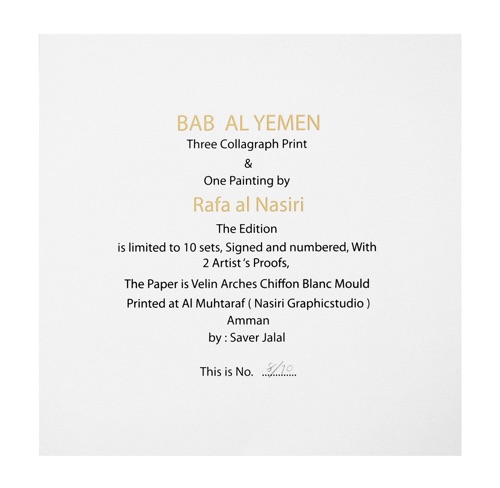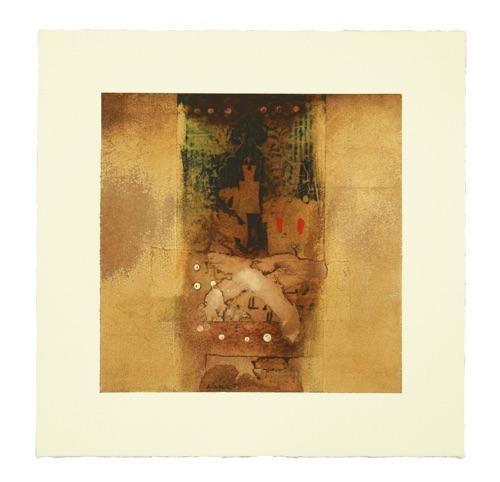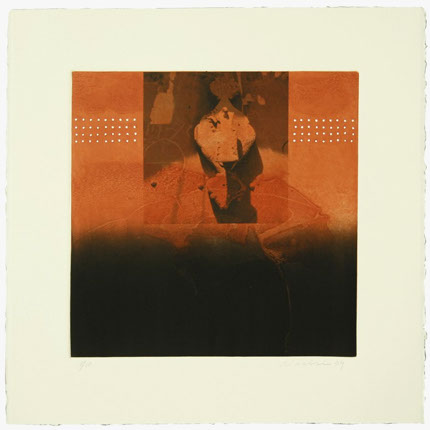
1
Living as an expatriate, far from my Homeland “Iraq”, and with the advance of age, time, past and present, old and new, seem to spontaneously overlap in such a way that permit the overflow of images and memories, great events and minor ones collaborate to form the main lineaments for each creative state of mind. In art, thoughts, colors and forms mingle with time and become one state which derives its viability from those human manifestations in order to be realized as a “painting”.
2
The art works I produced during the last seven years partly reflect my affinity with time. Roaming among the poetry of Al-Mutanabi (10th century AD), Ibn Zaidoun from Andalusia, to modern times through the poetry of Al Jawahiri, Mahmoud Darwish, Etel Adnan and May Muzaffar, is to wander about different times valuing homeland, love and beauty. They ardently overflow in the core of what I really aspire to reflect in my art works: paintings or prints.
3
As it appears in all the stages of my personal experience, the employment of Arabic character in some of my paintings is purely symbolic and referential. Nature to me is an element of beauty aims to complement and back up the basis of my painting in order to embody the traits of time and place to which I am referring.
Amman, September 2010
work from Rafa al-Nasiri
Rafa al Nasiri


%20a%20copy.jpg)


Green Art Gallery
Dubai,
December
2008
Bawabat (gates) by : Salwa Mikdadi_Curator – Art Historian, Amman, Nov. 2008
In this new series of works Nasiri elucidates the essence of his conviction that art is the gateway to the innermost consciousness of man. Taking the cosmic creation as an inspiration Nasiri draws on matter, space and time to engulf the visitor in a spiritual experience manifested by his exceptional ability in manipulating color and form. Since the late sixties terrestrial tones of brown and celestial blues replay the primordial act first as a cosmic soup of blue which over time divides into two entities, earth and sky.
Whether in print or on canvas the tension between the rectangular shades of blue and the horizontal strata suggests a pervasive cosmic mystery from which life and consciousness is born. Not far from Nasiri’s birthplace the Sumerian mythology described a primeval sea (abzu) in which heaven (an) and the earth (ki) were formed and in between the two was an atmospheric chamber (lil)where the stars, sun, planets, and moon existed above the a flat disc earth. It is within this universe of order and disorder that Nasiri seeks to convey a sense of harmony between man and nature. The absence of human figure in all his art compels the viewer to reflect on man’s relationship to the universe.
In most of the pieces in this exhibition the earth recedes and the sky dominates the canvases in shades of dark to light blue. There is a sense of doom in the sky where the paint drips from the darker recesses as if weeping onto the white spaces once occupied by earth. Drawing on the materiality of printmaking Nasiri, who is one of the foremost printmakers in the Arab world, embodies in his paintings elements from his signature etchings. The large black brush strokes that curve at each end are reminiscent of his early work influenced by Chinese art; other broad brush stokes are scratched like etching into acrylic. His pictorial structure calls to mind works by abstract expressionist such as Hans Hoffman, Clifford Still and Mark Rothko.
The seamless merging of calligraphic print with acrylic paint attests to the artist’s mastery of printmaking techniques, such expert assimilation of painting and printmaking is an example of how two forms of art can be integrated. Too often new forms of art such as digital art are favored over another without considering the creative possibilities of marrying classical art forms with new technologies. In Untitled (2008) Nasiri incorporates a silk screen print of the Arabic calligraphic thulth script onto the canvas. The script which is not meant to be read hangs in the background horizontally and is set vertically in the foreground where the script’s curvilinear lines form a calligraphic curtain or gate to the unknown. Suspended from a black arched frame the ‘curtain’ evokes Al-muàlàqat the pre-Islamic poems which were hung on the Kaaba.
Whether in prints, canvases or art books Nasiri’s art opens new gates of consciousness that empower the visitor to contemplate man’s relationship to nature and to the current human condition.
Salwa Mikdadi
Curator – Art Historian, Amman, Nov. 2008
Patina
::
Al Riwaq Gallery
Manama,
Bahrain
November
2006
Poetic
Apstractions
Homage
to al Mutanabi
::
Al Riwaq Gallery
Manama
April
2002
&
4walls Gallery
Amman
December
2002
::
4walls Gallery
Amman
October
2004.
,
Atassi Gallery
Damascus
November
2004
&
Green Art Gallery
Dubai
February
2005
%20a.jpg)
started 1 MAY 2010 email : info@ila-magazine.com
design: gitta pardoel logo: modhir ahmed © ila-magazine